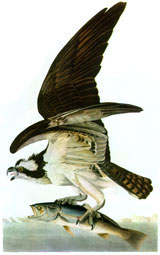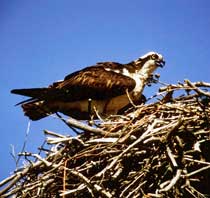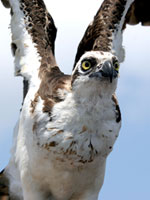|

Weights and Measures: The Osprey is 52-60cm (20.5-23.6 inches) long with a 152-167cm (5-5.5
feet) wingspan. It has white underparts and long, narrow wings with
four "finger" feathers at the end of each, which give it a very distinctive appearance.
You are What you Eat: The Osprey is particularly well adapted to its diet, with reversible outer toes, closable nostrils to keep out water during dives, and backwards facing scales on the talons which act as barbs to help catch fish.

Call of the Osprey: The call of the Osprey is a series of sharp whistles, cheep, cheep, or yewk, yewk. Near the nest, a frenzied cheereek!
 Hunting: The Osprey locates its prey from the air, often hovering prior to plunging feet-first into the water to seize a fish. As it rises back into flight the fish is turned head forward to reduce drag. The 'barbed' talons are such effective tools for grasping fish that, on occasion, an Osprey may be unable to release a fish that is heavier than expected. This can cause the Osprey to be pulled into the water, where it may either swim to safety or succumb to hypothermia and drown. Hunting: The Osprey locates its prey from the air, often hovering prior to plunging feet-first into the water to seize a fish. As it rises back into flight the fish is turned head forward to reduce drag. The 'barbed' talons are such effective tools for grasping fish that, on occasion, an Osprey may be unable to release a fish that is heavier than expected. This can cause the Osprey to be pulled into the water, where it may either swim to safety or succumb to hypothermia and drown.
Ospreys in Danger: Twenty to thirty years ago, Ospreys in some regions faced possible extinction, because the species could not produce enough young to maintain the population. Since the ban of DDT
in many countries in the early 1970s, together
with reduced persecution, the Ospreys, as well as
other affected bird of prey species are making significant recoveries.

A Place to Call Home: It breeds by freshwater lakes, and sometimes on coastal brackish waters. The nest is a large heap of sticks built in trees, rocky outcrops, telephone poles or artificial platforms. In some regions with high Osprey densities, such as Chesapeake Bay, USA, most Ospreys do not start breeding until they are five to seven years old.
 Many of the structures they need to build nests on are already taken. If there are no nesting sites available, young Ospreys may be forced to delay breeding. To ease Many of the structures they need to build nests on are already taken. If there are no nesting sites available, young Ospreys may be forced to delay breeding. To ease
this problem, posts may erected to provide more sites.
Life-long Lovers: Ospreys usually mate
for life. In March or earlier depending
on
region, they begin a five-month period of partnership to raise their young. Females
lay 3–4 eggs by late April, and rely on the size of their nest to help conserve heat.
The eggs are approximately the size of chicken eggs, and cinnamon colored. The eggs generally incubate for 5 weeks. After hatching, 2-ounce chicks become fliers within eight weeks. When food is scarce, the first chicks to hatch are most likely to survive. The typical lifespan is 20-25 years.

 The One and Only...
The Osprey differs in several respects from the other diurnal birds of prey, and has always presented something of a riddle to the taxonomist. Here it is treated as the sole member of the family Pandionidae, and the family listed in its traditional place as part of the order Falconiformes. The One and Only...
The Osprey differs in several respects from the other diurnal birds of prey, and has always presented something of a riddle to the taxonomist. Here it is treated as the sole member of the family Pandionidae, and the family listed in its traditional place as part of the order Falconiformes.
Other schemes place it alongside the hawks and eagles in the family Accipitridae—which itself
can be regarded as making up the bulk of the order Accipitriformes or else be lumped with the Falconidae into Falconiformes— and others again
group it alongside the other raptors in a greatly enlarged Ciconiiformes.
On Osprey! The Osprey is the official bird of Nova Scotia in Canada and Sudermannia in Sweden. It is the official mascot and team name for the University of North Florida and the Richard Stockton College of New Jersey. The bird was depicted on the 1986 series Canadian $10 note.
All text is available under the terms
of the GNU Free Documentation License
|